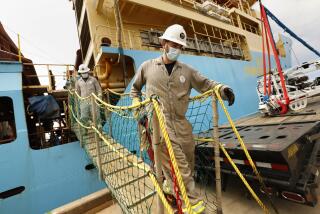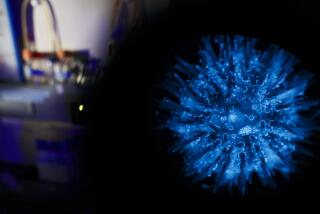Ocean robots take the pulse of our planet by measuring microbes
- Share via
It looks like a trashcan bobbing in the waters off the California coast. But it’s hardly garbage. In fact, it may play a key role in monitoring the health of our oceans.
The vital signs? The health of the seas’ smallest residents — phytoplankton.
From diatoms encased in glass to dinoflagellates that can cause toxic algae blooms, phytoplankton are a diverse group of algae that live in the ocean. They serve as the base of the ocean food chain and are responsible for cycling nutrients in the water and producing oxygen through photosynthesis.
“One out of every two breaths of oxygen that you take is coming from plants in the ocean, and most of the time people don’t think about them because they’re microscopic,” said Bethany Kolody, a graduate student researcher at the Scripps Institution of Oceanography in San Diego.
But the diversity of phytoplankton makes it difficult to predict how they will respond to changes in the ocean — especially those due to global warming — and how their reactions will affect ocean health as a whole.
An influx of nutrients into a particular area can fuel a massive algae growth. Changing water temperatures can shift the distribution of available food sources. Patches of the sea can absorb carbon dioxide and acidify.
All of these changes require phytoplankton to respond to new pressures. Unfortunately, eavesdropping on them can be a bit of a challenge.
If researchers don’t happen to have an expedition planned when one of these ocean events occurs, it might as well not have happened, said Andrew Allen, a microbial oceanographer and ecologist at Scripps.
“You really need to be at the right place at the right time to sample,” he said.
One solution may come in the form of “a lab in a can,” said molecular biologist Chris Scholin, president and chief executive of the Monterey Bay Aquarium Research Institute (MBARI). It’s an ocean-going robot that brings the tools of a molecular biology lab to the sea.
This robot, called the Environmental Sample Processor — or ESP for short — was developed about 15 years ago by Scholin and his team at MBARI.
Scholin came up with the idea while he was studying harmful algae blooms in the Gulf of Maine.
“I was just blown away by how people would go to sea and put instruments in the water, and they could tell you everything that was going on,” he said. “But when it came time to actually count the toxic algae for public health purposes and research, it would take us days.”
So Scholin and his colleagues set to work.
First, they had to figure out what it would take to engineer and construct this ocean robot.
Collecting water samples underwater, where the pressure is higher than it is on land, was one hurdle. Taking a sample large enough to fill a household bucket and condensing it into just a few drops for molecular analysis was another.
Once samples were collected, the robot would need to be able to collect and store genetic material from ocean microbes without refrigerating or freezing them.
“It was a little bit bigger of a job than I thought it was,” Scholin said.
After extensive research and tests, the ESP that debuted in 2006 was able to gather DNA samples and record water temperatures. It noted its precise location and drift speed as each sample was taken, allowing researchers to correlate their results with changing ocean conditions. It could even analyze the DNA features of the organisms it collected and send the information back to researchers waiting on land with just a slight delay.
There are more than 20 ESP robots currently in use by labs all over the world. Most are in the U.S., but one is in Denmark and two others are on their way to China, Scholin said.
Stephanie Moore, a research oceanographer at National Oceanic and Atmospheric Administration’s Northwest Fisheries Science Center, has deployed an ESP off the coast of Washington in a spot that’s known for algae blooms. These toxic growths of algae can turn shellfish poisonous and sicken fish.
“If we see some of the harmful algae cell concentrations or maybe toxin concentration creeping up, we can trigger [the ESP] to take an additional sample,” Moore said. “Having that two-way communication with the instrument the whole time is really beneficial.”
The robots are especially great for monitoring microbes in remote areas where it would be expensive to charter research expeditions, she added.
The ESP has also helped researchers investigate the genetics of phytoplankton.
Kolody, Allen and their colleagues at Scripps recently analyzed data collected by an ESP off the coast of California to see how the diverse population of microbes living there decided which of their genes to turn on or off throughout the day. The robot was able to drift with the currents and take samples of the same population of microbes every four hours.
“We can finally get a sense of how this population is changing over time and how it reacts to different drivers in the environment — changes in sunlight, changes in nutrients, interactions between members of the population,” Kolody said.
Scholin’s team at MBARI is hard at work on a new ESP that will be small enough to attach to an autonomous underwater vehicle.
A recent study from researchers at MBARI and NOAA showed that this latest robot is able to sample the DNA that marine organisms leave behind in the environment.
“Not only are all these microorganisms there, but actually traces of larger animals that you don’t necessarily see or catch in your one little sample of water,” Scholin said.
Using these ESPs to collect environmental DNA will be important for monitoring the presence of invasive species and for studying the biodiversity of the ocean.
Scholin’s goal is that in the future, “we would just have these things all over the place, just like weather stations,” he said.
“This is just the very beginning of this kind of field,” he said. “To use the analogy of music, we’re nowhere near the point where we can stream. We’re still in the recording and playback stage at this point. But it’s getting there. It’s a real opportunity for engineers and scientists and environmental groups to work together.”






